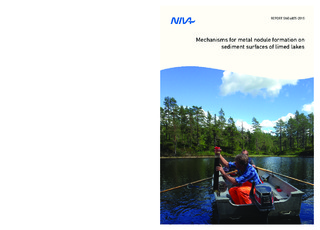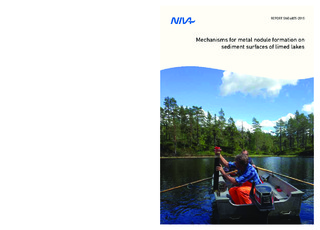| dc.contributor.author | Hindar, Atle | |
| dc.contributor.author | Couture, Raoul-Marie | |
| dc.contributor.author | Eriksen, Tor Erik | |
| dc.contributor.author | Rognerud, Sigurd | |
| dc.contributor.other | Hindar, Atle - Project manager | |
| dc.date.accessioned | 2015-09-22T13:57:35Z | |
| dc.date.accessioned | 2015-09-23T11:06:10Z | |
| dc.date.available | 2015-09-22T13:57:35Z | |
| dc.date.available | 2015-09-23T11:06:10Z | |
| dc.date.issued | 2015 | |
| dc.identifier | 6875 | |
| dc.identifier.citation | NIVA-rapport. 35 p. Norsk institutt for vannforskning, 2015 | nb_NO |
| dc.identifier.isbn | 978-82-577-6610-8 | |
| dc.identifier.issn | 1894-7948 | |
| dc.identifier.uri | http://hdl.handle.net/11250/301393 | |
| dc.description | | nb_NO |
| dc.description.abstract | The water chemical and biological effects of liming have been fairly well documented. One of the research projects revealed relatively large (up to 1-3 cm in diameter) metal nodules on the sediment surface of some of the limed lakes. Here, we report on results for sediment and porewater metal content and densities of profundal macroinvertebrates from an in-depth investigation of two of 17 previously examined limed lakes. Trace element concentrations (especially of Mo and U) in Djupøyungen sediments are especially high, probably caused by the sulphide-containing bedrock, typical for the area. The metals in the sediment porewater are characterised by their association with Fe and Mn oxides and sulphides (Co, As and Mo) or S (U) and diagenetic separation (Cd and Mn). Significant Mn enrichment is probably due to facilitated precipitation of Mn oxides at the increased pH after liming. Gentle flushing of grab samples revealed a total dominance of Mn and Fe nodules on the sediment surface in some parts of Breisjøen. Although comparisons with Norwegian and other guidelines for sediments indicate that the measured concentrations for some of the metals are significantly above acceptable limits, data from only one of the sampling sites indicate effects on invertebrates. Residual Ca from the liming may protect the biota from negative effects. | nb_NO |
| dc.description.sponsorship | Norwegian Environment Agency | nb_NO |
| dc.language.iso | eng | nb_NO |
| dc.publisher | Norsk institutt for vannforskning | nb_NO |
| dc.relation.ispartofseries | NIVA-rapport;6875 | |
| dc.rights | Navngivelse-Ikkekommersiell-DelPåSammeVilkår 3.0 Norge | * |
| dc.rights.uri | http://creativecommons.org/licenses/by-nc-sa/3.0/no/ | * |
| dc.title | Mechanisms for metal nodule formation on sediment surfaces of limed lakes | nb_NO |
| dc.type | Research report | nb_NO |
| dc.date.updated | 2015-09-22T13:57:35Z | |
| dc.rights.holder | Norsk institutt for vannforskning / Norwegian institute for water research | |
| dc.subject.nsi | VDP::Matematikk og naturvitenskap: 400 | nb_NO |
| dc.subject.nsi | VDP::Mathematics and natural scienses: 400 | nb_NO |
| dc.source.pagenumber | 35 | nb_NO |
| dc.identifier.cristin | 1266557 | |
| dc.subject.keyword | Innsjøsedimenter / Lake sediments | |
| dc.subject.keyword | Invertebrater / ryggradsløse dyr / Invertebrates | |
| dc.subject.keyword | Kalking / Liming | |
| dc.subject.keyword | Metallutfelling / Metal precipitation | |
| dc.relation.project | 13356 | nb_NO |



